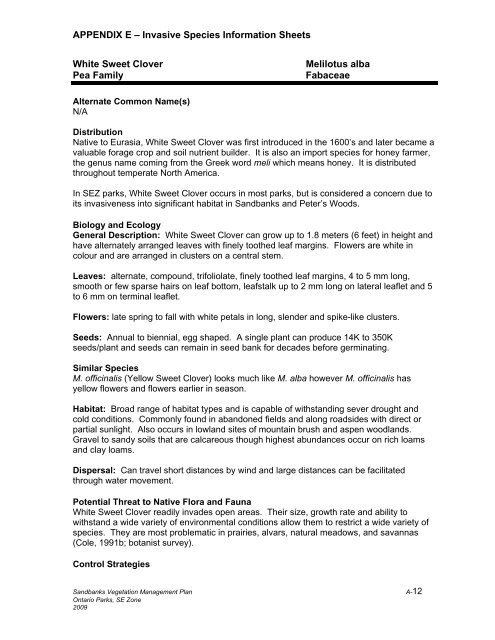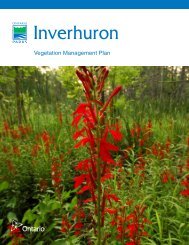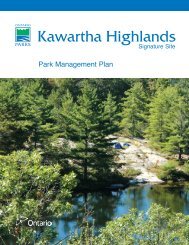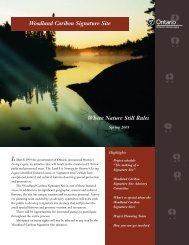Sandbanks Draft Veg Mgmt Plan - Ontario Parks
Sandbanks Draft Veg Mgmt Plan - Ontario Parks
Sandbanks Draft Veg Mgmt Plan - Ontario Parks
Create successful ePaper yourself
Turn your PDF publications into a flip-book with our unique Google optimized e-Paper software.
APPENDIX E – Invasive Species Information Sheets<br />
White Sweet Clover<br />
Pea Family<br />
Melilotus alba<br />
Fabaceae<br />
Alternate Common Name(s)<br />
N/A<br />
Distribution<br />
Native to Eurasia, White Sweet Clover was first introduced in the 1600’s and later became a<br />
valuable forage crop and soil nutrient builder. It is also an import species for honey farmer,<br />
the genus name coming from the Greek word meli which means honey. It is distributed<br />
throughout temperate North America.<br />
In SEZ parks, White Sweet Clover occurs in most parks, but is considered a concern due to<br />
its invasiveness into significant habitat in <strong>Sandbanks</strong> and Peter’s Woods.<br />
Biology and Ecology<br />
General Description: White Sweet Clover can grow up to 1.8 meters (6 feet) in height and<br />
have alternately arranged leaves with finely toothed leaf margins. Flowers are white in<br />
colour and are arranged in clusters on a central stem.<br />
Leaves: alternate, compound, trifoliolate, finely toothed leaf margins, 4 to 5 mm long,<br />
smooth or few sparse hairs on leaf bottom, leafstalk up to 2 mm long on lateral leaflet and 5<br />
to 6 mm on terminal leaflet.<br />
Flowers: late spring to fall with white petals in long, slender and spike-like clusters.<br />
Seeds: Annual to biennial, egg shaped. A single plant can produce 14K to 350K<br />
seeds/plant and seeds can remain in seed bank for decades before germinating.<br />
Similar Species<br />
M. officinalis (Yellow Sweet Clover) looks much like M. alba however M. officinalis has<br />
yellow flowers and flowers earlier in season.<br />
Habitat: Broad range of habitat types and is capable of withstanding sever drought and<br />
cold conditions. Commonly found in abandoned fields and along roadsides with direct or<br />
partial sunlight. Also occurs in lowland sites of mountain brush and aspen woodlands.<br />
Gravel to sandy soils that are calcareous though highest abundances occur on rich loams<br />
and clay loams.<br />
Dispersal: Can travel short distances by wind and large distances can be facilitated<br />
through water movement.<br />
Potential Threat to Native Flora and Fauna<br />
White Sweet Clover readily invades open areas. Their size, growth rate and ability to<br />
withstand a wide variety of environmental conditions allow them to restrict a wide variety of<br />
species. They are most problematic in prairies, alvars, natural meadows, and savannas<br />
(Cole, 1991b; botanist survey).<br />
Control Strategies<br />
<strong>Sandbanks</strong> <strong>Veg</strong>etation Management <strong>Plan</strong> A-12<br />
<strong>Ontario</strong> <strong>Parks</strong>, SE Zone<br />
2009
















